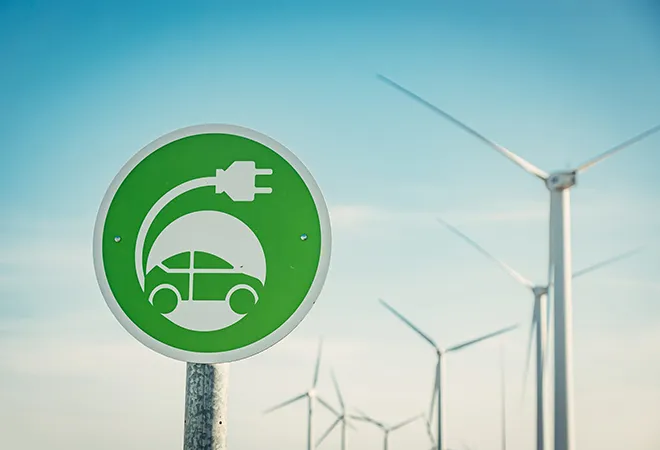
India’s announcement of a net-zero target is a signal of climate action—a much-awaited move by many developed nations to justify their own commitments with a perceived level playing field. To translate this target into reality, laying out a pathway to reduce emissions is going to be the next step. It will be necessary to transform the economy and its sectors. Businesses have a pivotal role to play in this. Their actions, resources, capacity to innovate, and greater reach are vital to swiftly decarbonise sectors, infrastructure, value chains, and the products and services they provide. Businesses are already playing a key role in the climate fight, helped by the growing customer and investor focus on sustainability, as well as increasing regulatory and disclosure requirements. A rising number of companies have announced net-zero ambitions over the last year. Some of India's biggest companies have declared net-zero targets, including Reliance Industries (RIL), Tata Consultancy Services (TCS), HDFC Bank, Wipro, Infosys, Mahindra & Mahindra, JSW Energy, ITC, Adani, Dalmia Cement, and Indian Railways. Apart from these, 64 Indian companies have pledged to reduce greenhouse gas (GHG) emissions, according to the Science-Based Target Initiative—a global alliance that enables businesses to establish their own climate pledges.
What does net zero mean for businesses?
Net zero is a state in which the activities within the value chain of a company result in no net impact on the climate from GHG emissions.
What is the business case for net zero?
It is not just governments that are thinking green. More investors are using environmental, social, and governance (ESG) considerations in their investment process and they are doing so in a more integrated and systematic way. Climate change is the most important ESG issue considered by asset managers today. 2020 was a record year for ESG inflows, with global assets in sustainable funds ending the year at approximately US $1.7 trillion, up about 67 percent from nearly US $1.0 trillion at the end of 2019. According to Morningstar's 2020 Annual Report, net inflows to sustainable funds increased rapidly sequentially in 2020, with the fourth quarter of 2020 net inflows recording an increase of 150 percent against the fourth quarter of 2019. Europe leads in terms of growth in sustainable assets, followed by the US. However, it will not be long before India, too, follows in the footsteps of Europe and the US on ESG disclosures.
2020 was a record year for ESG inflows, with global assets in sustainable funds ending the year at approximately US $1.7 trillion, up about 67 percent from nearly US $1.0 trillion at the end of 2019.
Through the Business Responsibility and Sustainability Reporting (BRSR), the Securities and Exchange Board of India (SEBI) has specified an intricate methodology for reporting on climate change and other topics, which is mandatory for the Top 1,000 listed companies from FY 2022-23, and voluntary from FY 2020-21. Transparency about businesses' environmental footprints is increasing, and greener companies are benefiting from higher valuations and finance. Investors are interested not only in previous emissions, but also in what the carbon footprints of companies will look like in the future. This is encouraging more businesses to develop emission-reduction strategies and hold themselves accountable for progress toward reaching them.
Boardrooms are being asked not only for objectives, but also for strategies for climate transition. To meet these objectives, business leaders require a credible approach—and even those with current net-zero pledges require a strategy to solve the most difficult decarbonisation difficulties. Businesses are well-positioned to not just adapt to but also gain from a net zero transition. This is especially true for enterprises that offer ‘green’ solutions to society’s problems, or those who can assist communities in building resilience to the physical effects of climate change. Climate action will not only transform industries, but it will also likely reshape how investment choices are made and where money flows. More capital is expected to be directed toward companies that are at the forefront of the climate transition, while climate laggards may face financing challenges or reduced values.
Boardrooms are being asked not only for objectives, but also for strategies for climate transition. To meet these objectives, business leaders require a credible approach—and even those with current net-zero pledges require a strategy to solve the most difficult decarbonisation difficulties. Businesses are well-positioned to not just adapt to but also gain from a net zero transition.
How can businesses join the net zero movement?
A credible net zero strategy entails removing emissions sources in the value chain at a rate and scale commensurate with reducing global warming to 1.5°C as much as possible, and then removing any remaining emissions that are difficult to eradicate through permanent carbon dioxide removals. Companies should, therefore, set shorter-term, science-based targets that address all GHGs and commit to decarbonise both their footprint and their value chain. As a result, the initial step is to comprehend emissions. Every company's road to decarbonisation begins with a thorough value chain GHG baseline and footprint assessment. Measuring Scope 1 (direct: From a company’s own activities), 2 (indirect: From the generation of purchased electricity), and 3 (indirect: Along the value-chain) emissions are, nevertheless, an important first step in building a precise net-zero plan that displays trustworthiness to investors, customers, civil society, and other stakeholders. Once the emissions have been estimated, the next stage is to develop a strategy for reducing and finally eliminating these emissions. For example, a company may find it simple to replace its cars with electric vehicles or to sign a contract for solar electricity. However, implementing decarbonisation across its shops, factories, offices, and other facilities is a critical challenge. Accounting for its suppliers becomes even more complicated and these generally account for the bulk of a company's overall carbon footprint, yet it has no direct control over them.
For example, a company may find it simple to replace its cars with electric vehicles or to sign a contract for solar electricity. However, implementing decarbonisation across its shops, factories, offices, and other facilities is a critical challenge.
Regular review of the process and actions taken is crucial since it will enhance future efforts to eliminate and offset emissions. Furthermore, it will increase understanding of successful ways as well as potential pitfalls to guarantee that the following cycle is more productive than the previous one. Another important step in aligning corporate goals with the net zero target is disclosure. Communicating about climate action helps to build relationships with the public while also raising awareness for other business owners to run carbon-neutral operations. Additionally, with greater scrutiny of business net-zero commitments, it is imperative that this carbon footprint accounting is credible and transparent as climate-related disclosures have spurred more asset managers and owners to examine the climate risks in their own holdings. Each company's journey to net zero is distinct, and there is still much to be learned about the issues that businesses will confront along the way. For some, capitalising on these prospects may require expanding current operations, forming strategic alliances, or identifying new market entry points. Others will need to invest in cutting-edge climate technology, new attitudes, and the rewiring of their operations and supply chains.
The path to net-zero might be difficult for small and medium-sized enterprises (SMEs). Many of them are involved in supply networks. They also serve as a supply basis for larger corporations. Therefore, larger companies should assist smaller ones in reducing their individual and collective carbon impact. They must contribute to the creation of the environment necessary for effective, just, and long-term climate solutions. Businesses in India can contribute to this mission by balancing people, profit, and the environment. Net-zero targets must be accompanied by detailed transition plans that include immediate, short-, and long-term milestones for deep emissions reductions, investments in innovation and new business models; upskilling and reskilling to enable an inclusive workforce transition; enhanced support for SME partners and suppliers, integration of social indicators into net zero reporting and disclosure; and inclusion in their approach. The eventual objective must be a thriving, socially just, net zero future, not merely net zero.
The views expressed above belong to the author(s). ORF research and analyses now available on Telegram! Click here to access our curated content — blogs, longforms and interviews.




 PREV
PREV


